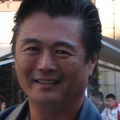Read Part 1 >>
Recently, in Minneapolis, Pangea World Theater presented Lebanese American writer Kathy Haddad’s Zafira: The Olive Oil Warrior, a work which imagines Arab and Muslim Americans being rounded up and interned in a manner similar to Japanese Americans in World War II. The play even employed a quotation from a 1942 LA Times editorial calling for the internment of Japanese Americans and merely substituted the term Arab Americans. I was one of the few audience members who recognized the quotation that so accurately mimicked the conditions today. (Since 9/11, 85,000 Arab and Muslim Americans have been arrested.)
In 1991, along with other Twin Cities Asian Americans, I helped form the Asian American Renaissance, an Asian American arts organization. Members of the Arab American community asked if they could be part of the organization, and we readily agreed. Whether one accepts or not the extension of Asian American to the Middle East and not just the Far East and South Asia, it’s hard to deny the connections and parallels between our histories and conditions.
The connections and merging of Arab and Muslim Americans, who of course include South Asian Muslims, with Asian America is just one facet of the increased diversity of the Asian American population. For many Asian Americans, the multiplicity of their interracial and interethnic encounters is unprecedented in our history (though we know the encounters of previous generations were far more diverse than is often acknowledged).
Of course I am aware that there are places like Edison, New Jersey, or Monterey Park, California, where Asian Americans can live their lives solely within an ethnic enclave, socializing and working only with those of their own ethnicity. But elsewhere in the country the experience of Asian Americans is just the opposite. For example, my children’s Minneapolis high school is one-fifth Native American, one-fifth Latino, one-fifth black (including West Africans), one-tenth Asian, and three-tenths European Americans. My children’s friends have been black, white, mixed race, Tibetan, Somali, Ethiopian, Eritrean, Bosnian, Chicano, Tunisian, Native, Hmong, Thai, and Chinese. Their girlfriends and boyfriends have been white, Korean adoptees, Thai, Puerto Rican, Somali, Ethiopian. This diversity of race and ethnicity has shaped who my children are and who their friends are in ways that represent a new generation of Asian Americans. It’s not a post-racial America they’re living in but a multiracial America. And this is Minnesota, people, not New York or London.
Though I’m Japanese American, I grew up mainly thinking of race as a dialogue between whites and America-born blacks. In recent years, in part due to my children’s experiences, I’ve found myself expanding and complicating my conceptions of racial dialogues. I now see such dialogues as including other racial and immigrant populations and their connections to a global vision. This process has been accelerated by ten years teaching at VONA, a writer’s conference for writers of color.
The ethnic/racial background of the VONA faculty is amazingly diverse, with writers like Junot Diaz, ZZ Packer, Chris Abani, Suheir Hammad, Cristina Garcia, Elmaz Abinader, Willie Perdomo, Ruth Foreman, Staceyann Chin, Faith Adiele, Lorna Dee Cervantes, Jimmy Santiago Baca, Thomas Glave, Victor Lavelle, Martin Espada, Saul Williams, Cherie Moraga, Andrew Pham, Walter Mosley, Danzy Senna, Matt Johnson, Quincy Troupe, Evelina Galang, and Chitra Divakaruni. My dialogues with such colleagues have enabled and caused me to learn more about their various cultures and histories. This has also been the case with the younger writers—including Asian American writers like Ishle Park, Katie Vang, Mai Lee, Ching-In Chen, Allison Towata, Parissa Ebrahimzadeh, Sharline Chiang—who have studied at VONA. Some of these younger writers are refugees from white-dominated MFA programs where their instructors and classes don’t even acknowledge such diversity exists, much less its significance.
To understand the tradition and context out of which writers like Junot Diaz, Suheir Hammad, or Chris Abani write, you need to be aware of the likes of Said and Fanon, of Patrick Chamoiseau and Chinua Achebe, of Mahmoud Darwish and Derek Walcott. In studying how Palestinian Americans like Suheir Hammad view Palestinian history—something you will never get from the American media—Said is essential. And if you read Said on Palestine—or on Orientalism or his investigation into the ways imperialism informs British literature—that will lead you to Fanon’s Wretched of the Earth and Black Skin, White Masks. The latter then provides a necessary gloss on Diaz’s “How to Date a Browngirl, Blackgirl, Whitegirl, or a Halfie” and the hierarchy of color that exists in the Dominican Republic of Oscar Wao.
But it’s not just writers of color who must be read in a context beyond the white Anglo-American tradition. With the addition of these post-colonial writers, we must also transform our view of the Anglo-American tradition. Yeats becomes a poet of decolonization as opposed to a major British poet (which is how I was first introduced to Yeats). Given his problematic explorations of colonialism and empire, Conrad becomes a pivotal figure for Said in Culture and Imperialism and his work a telling contrast with Austen’s Mansfield Park, where the colonial source of wealth is kept conveniently offstage; for Chinua Achebe, it’s the egregious aspects of Conrad’s Heart of Darkness which trigger the birth of his groundbreaking novel, Things Fall Apart; for Diaz, Conrad has been instrumental in understanding certain questions of narration (take a look at the similarities between the ways Junior and Marlowe function as narrators).1
The Asian American writers today who wish to join the ranks of Jonathan Franzen, David Foster Wallace, Nicole Krauss, Lydia Davis, or Alice Monroe can continue their work without the references I’ve listed above. But those Asian American writers who want to join the ranks of a Salman Rushdie, V.S. Naipaul or Edwidge Danticat, a Nurrudin Farah, Jamaica Kincaid or Junot Diaz? They’re headed in a different direction. They will have to educate themselves in a world and a literature that’s generally not available in the academy’s MFA programs. They will have to enter the America that exists today outside the white suburbs or the mono-ethnic enclaves. They will have to shift and transform their own identities in order to make themselves adequate to this brave new world.
In my own exploration of Asian American identity two key quotations charted the type of exploration I am urging Asian American writers of the next generation to make. The first is from Frantz Fanon’s psychological study of race and colonialism, Black Skin, White Masks:
In the Antilles...in the magazines, the Wolf, the Devil, the Evil Spirit, the Bad Man, the Savage are always symbolized by Negroes or Indians; since there is always identification with the victor, the little Negro, quite as easily as the little white boy, becomes an explorer, an adventurer, a missionary “who faces the danger of being eaten by the wicked Negroes”...The black school boy in the Antilles, who in his lessons is forever talking about “our ancestors, the Gauls,” identifies himself with the explorer, the bringer of civilization, the white man who carries truth to savages—an all-white truth. There is identification—that is, the young Negro subjectively adopts a white man’s attitude. He invests the hero, who is white, with all his own aggression—at that age closely linked to sacrificial dedication, a sacrificial dedication permeated with sadism.
Fanon’s argument here is clear: in the French colonial education system, what the young black school boy learns is self-alienation, self-hatred, and an identification with his white colonial rulers. At the time I encountered Fanon, I was someone who had gone through an English Ph.D. program where I had been taught no writers of color except for a handful of Baraka poems. And I said to myself, Oh, I’m that black school boy. All I’ve been learning is the “all-white truth.” Now I do understand that today’s younger Asian American writers receive a training that is at least slightly more diverse than mine, but they should also remember that many of their teachers—the writers of my generation—white or of color, received mainly a monoracial, monocultural formal education, an education that did not include the issues of post-coloniality.
A second essential guide for a young Asian American writer would be the following quotation from James Baldwin’s The Devil Finds Work:
The question of identity is a question involving the most profound panic—a terror as primary as the nightmare of the mortal fall. This question can scarcely be said to exist among the wretched, who know, merely, that they are wretched and who bear it day by day—it is a mistake to suppose that the wretched do not know that they are wretched; nor does this question exist among the splendid, who know, merely, that they are splendid, and who flaunt it, day by day: it is a mistake to suppose that the splendid have any intention of surrendering their splendor. An identity is questioned only when it is menaced, as when the mighty begin to fall, or when the wretched begin to rise, or when the stranger enters the gates, never, thereafter, to be a stranger: the stranger’s presence making you the stranger, less to the stranger than to yourself. Identity would seem to be the garment with which one covers the nakedness of the self; in which case, it is best that the garment be loose, a little like the robes of the desert, through which robes one’s nakedness can always be felt, and sometimes, discerned. This trust in one’s nakedness is all that gives one the power to change one’s robes.
America has always been a place where a stranger encounters a stranger, but it is so much more so today.2 That is the America—and the world—that Asian American writers under forty are a part of. Whether they acknowledge this in their writing? Well, that’s up to them.
Notes:
1. One sticking point for so many writers of color, particularly fiction writers, is the economy of explanation: which of those details the white mainstream reader might not understand do you explain? In the Marlowe novels, Conrad has used the genre of the men’s club novel, where one of the club members tells a tale to the other members. Similarly Diaz’s Junior tells Oscar’s tale to an audience of urban, educated second or one-and-a-half generation Dominicans, who grew up on hip hop and American pop culture as well as the immigrant Dominican culture; this audience then determines his economy of explanation.
2. Much of this increased diversity is due to the Immigration Act of 1965, which opened up immigration from non-European nations and therefore allowed the parents of the Asian American generation under forty to immigrate here. Thus, the very presence of these Asian Americans must be seen in the context of the Civil Rights movement and the fight against racial discrimination. The other factor contributing to that generation is, of course, the Vietnam War, a war that cannot be understood without the context of colonialism and empire.
Next Forum response by Richard Oyama >>
*This article was first published in The Asian American Literary Review Spring 2012: Generations. The AALR has generously shared several of the forum responses, poetry, and prose with Discover Nikkei from this issue by David Mura, Richard Oyama, Velina Hasu Houston, Anna Kazumi Stahl, Amy Uyematsu, and Hiromi Itō (translated by Jeffrey Angles).
AALR is a not-for-profit literary arts organization. To learn more about it or purchase a subscription to the journal, visit online at www.asianamericanliteraryreview.org, or find them on Facebook.
© 2012 David Mura





